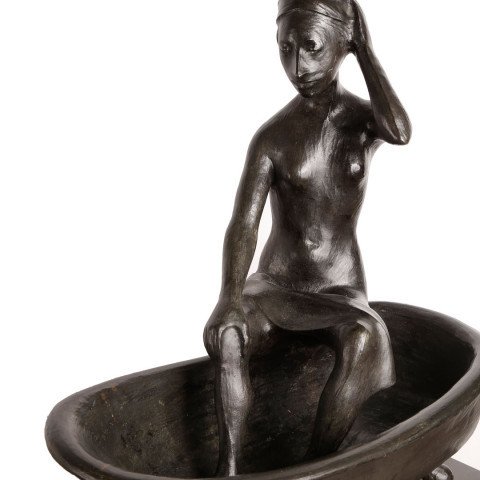Harry Marinsky was born in London to Russian parents who were both designers in the world of high fashion. When he was three, his family settled in Providence, Rhode Island. Harry's first exposure to sculpture was in the Technical High School in Providence, where he learned how to cast in sand and plaster. Harry received a scholarship to Rhode Island School of Design and then went on to study at Pratt Institute in New York City, where he expanded his training from fine art to commercial design. This education enabled him to secure employment in the competitive art market.
By the age of twenty-five, Marinsky was Art Editor of American Home, and Country Life magazines. After several years, he transitioned from his positions at the magazines to working as a free-lance commercial artist, providing illustrations for such publications as House Beautiful, House and Garden and Women's Day. In May of 1945, as World War II ended, Marinsky was inspired to create a sculpture series of seven groups of figures entitled One War - One Peace as a response to the social and political climate of the times.
In 1946, Marinsky left New York City for a home in Rowayton, CT on the Five Mile River. The change to a rural setting gave Marinsky the opportunity to explore his ongoing interest in landscape design, architecture, and gardening. He produced commissioned drawings, paintings, and designs, while continuing to work as a sculptor. In 1961 and 1962, Marinsky embarked on a one-year sabbatical during which he explored sixteen European countries and painted watercolor landscapes.
In 1968, Marinsky set off again, this time on a fortuitous journey which landed him at the Tomassi Foundry in Pietrasanta, Italy, dramatically altering the course of his artistic career. The Tomassi Foundry has attracted artists from around the world for centuries, producing work for such sculptors as Michelangelo, Pomodoro, Marini, Murabito, Lipchitz, and Lucchesi. Marinsky had found his place of inspiration, and moved to a Tuscan farmhouse in the village of Capriglia, just outside Pietrasanta, in 1972. For decades, he created all his sculptures in a studio on the grounds of the Tomassi Foundry.
Marinsky's exhibition of work, commissions, awards, and collections are numerous, his work has been collected worldwide for more than fifty years. His bronzes have been a part of a permanent collection in Florence, Italy at the Florence Art Gallery since 1970. He drew much inspiration from the Italian culture, of which he has become a part… the bicycles, umbrellas, loquaciousness and unparalleled passion for living. Harry Marinsky's figurative sculptures have survived the titles of "isms" in contemporary art over the last half-century, and stand as testimonies to the integrity of this visionary artist with prodigious and wide-ranging talent.

